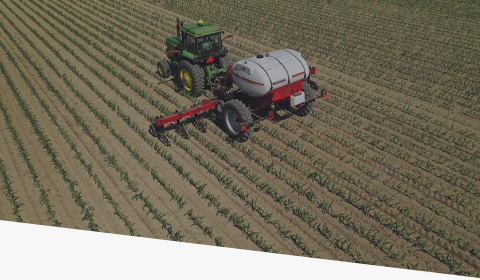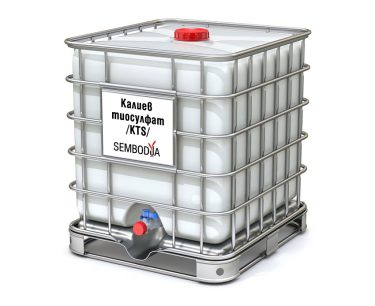- High concentration of potassium and sulphur
- 30% better potassium uptake compared to conventional potassium fertilisers
- Improves crop resistance to stress
- Increases protein production and its quality
- Helps translocation of sugars and starch
- Thiosulfate increases the chlorophyll content, supports the synthesis and functioning of enzymes and vitamins in the plant, applied in combination increases the efficiency of fertilizers, improves the absorption of nutrients in the soil
Potassium thiosulfate (KTS)
KTS is a high quality product with the highest content of water soluble potassium and sulphur on the market, without chlorides. KTS is a source of potassium in a ready to absorb form.
* For specific doses, phase of administration and overall feeding schedule, please contact our specialist or send an inquiry HERE.
KTS is a multi-purpose product – in terms of crop type, application phase, application timing, method and application rates. Our team of agronomists and specialists are available by region to assist you with KTS.
- KTS is compatible with solutions of urea ammoniacal nitrate (UAN) and ammonium polyphosphate (APP) in specific ratios.
- KTS mixtures with APP under normal conditions are turbid in appearance, but this does not affect their quality and performance. The KTS + UAN mixture should be used as soon as possible after its preparation.
- Only mixtures of UAN and KTS with more than 80% of one of the two components are stable without dilution.
- When mixing KTS and UAN, the amount of water to be added to the mixture is the amount of whichever of the two products is less (for example, in a mixture of 60 L of UAN with 40 L of KTS, the mixture should be diluted with 40 L of water). The mixing sequence should be: KTS, water, UAN.
- Mixtures with UAN should first be tested in small quantities before proceeding to larger quantities. At low temperatures, the potassium in KTS reacts with the nitrate group of UAN to form crystals of potassium nitrate. Addition of water or heating returns the crystals back into solution. Avoid introducing air into the KTS or into the mixture with the KTS.
- When mixing pesticides with KTS and other fertilisers, the mixing sequence should be: water, pesticide, KTS and/or other fertiliser. Always ensure that combinations of KTS with pesticides are compatible.
- KTS mixtures with trace elements should first be tested in small quantities. In most situations chelates of trace elements with neutral pH are preferred for mixing with KTS. Chelates with a strong or weak acid reaction do not mix well with KTS. Mixtures with KTS should not be acidified below pH 6.0.
- High concentration of potassium and sulphur
- 30% better potassium uptake compared to conventional potassium fertilisers
- Improves crop resistance to stress
- Increases protein production and its quality
- Helps translocation of sugars and starch
- Thiosulfate increases the chlorophyll content, supports the synthesis and functioning of enzymes and vitamins in the plant, applied in combination increases the efficiency of fertilizers, improves the absorption of nutrients in the soil
* For specific doses, phase of administration and overall feeding schedule, please contact our specialist or send an inquiry HERE.
KTS is a multi-purpose product – in terms of crop type, application phase, application timing, method and application rates. Our team of agronomists and specialists are available by region to assist you with KTS.
- KTS is compatible with solutions of urea ammoniacal nitrate (UAN) and ammonium polyphosphate (APP) in specific ratios.
- KTS mixtures with APP under normal conditions are turbid in appearance, but this does not affect their quality and performance. The KTS + UAN mixture should be used as soon as possible after its preparation.
- Only mixtures of UAN and KTS with more than 80% of one of the two components are stable without dilution.
- When mixing KTS and UAN, the amount of water to be added to the mixture is the amount of whichever of the two products is less (for example, in a mixture of 60 L of UAN with 40 L of KTS, the mixture should be diluted with 40 L of water). The mixing sequence should be: KTS, water, UAN.
- Mixtures with UAN should first be tested in small quantities before proceeding to larger quantities. At low temperatures, the potassium in KTS reacts with the nitrate group of UAN to form crystals of potassium nitrate. Addition of water or heating returns the crystals back into solution. Avoid introducing air into the KTS or into the mixture with the KTS.
- When mixing pesticides with KTS and other fertilisers, the mixing sequence should be: water, pesticide, KTS and/or other fertiliser. Always ensure that combinations of KTS with pesticides are compatible.
- KTS mixtures with trace elements should first be tested in small quantities. In most situations chelates of trace elements with neutral pH are preferred for mixing with KTS. Chelates with a strong or weak acid reaction do not mix well with KTS. Mixtures with KTS should not be acidified below pH 6.0.


